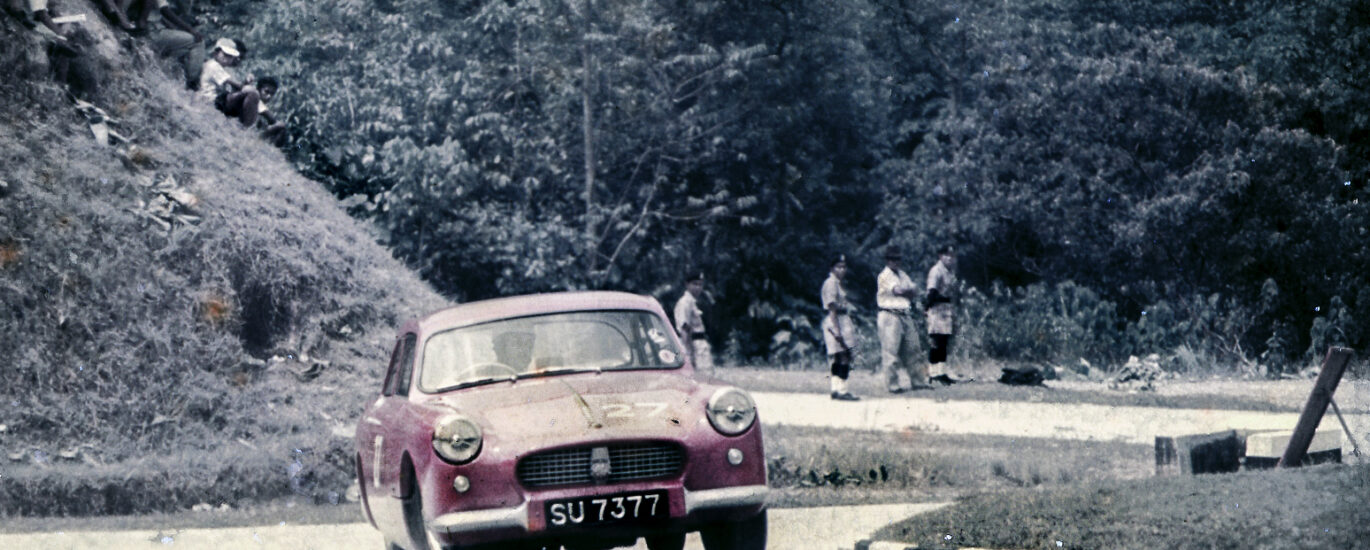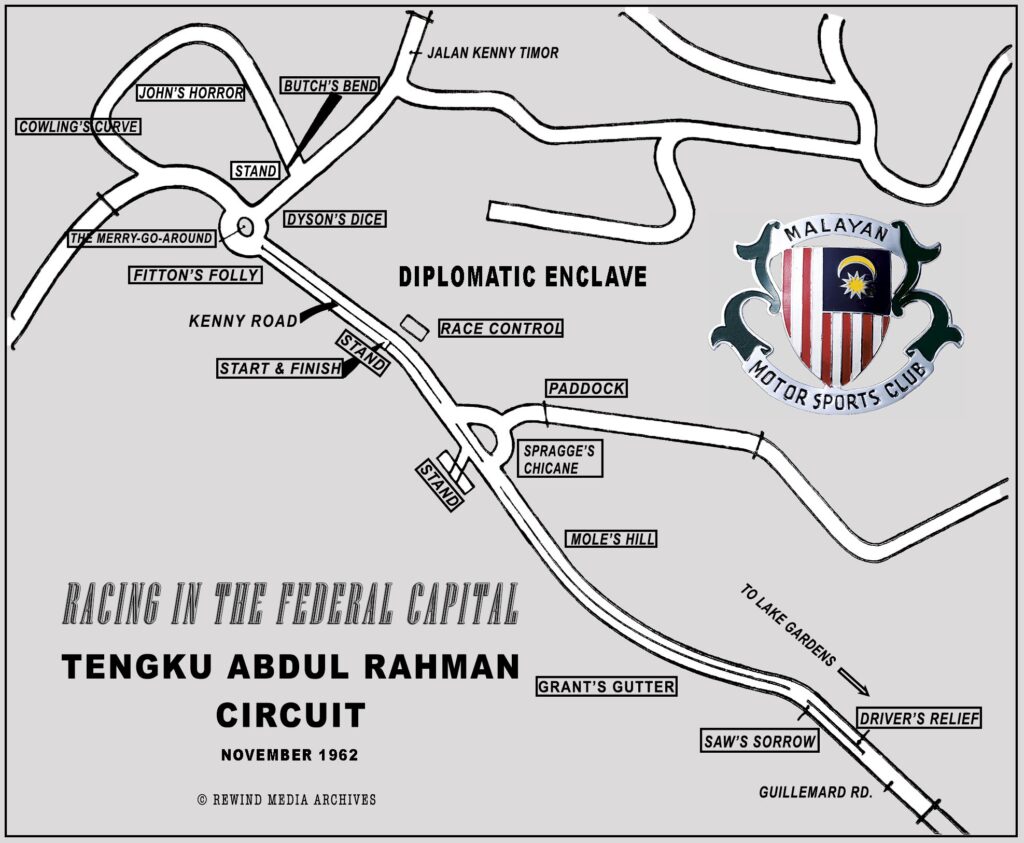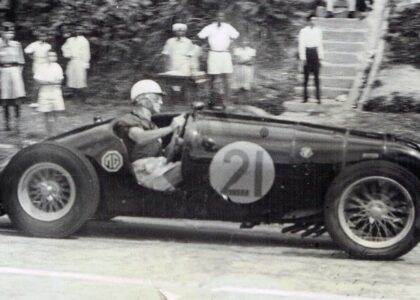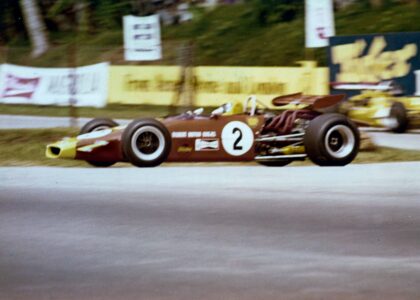Grand Prix roots in Kuala Lumpur
Back in August 2015 there was talk the there would be Kuala Lumpur street Grand Prix. It sparked a search in our office Archives for race programs for similar events in the 1950s and early 1960s. Sure enough, we had a few.
HUMBLE SPRINTS: Looking back at the racing scene in the late 1950s, there was a definite buzz amongst members of the larger motoring clubs in South East Asia, such as the Malayan Motor Sports Club, formed in 1953 [View: Mickey Boy’s Badge] and the Singapore Motor Club [View: Joy By Design]. They planned, they schemed, they sought venues, and they looked for the right cars. A trickle of sports and racing cars found their way to the region, imported by both locals and expatriates. Formula 3 Coopers, Lotus and Lolas added to the plethora of locally built Specials and fast sports cars.
The catalyst for this activity most certainly was the Forces Motoring Club’s circuit race at RAF Changi in Singapore in 1957. But it wasn’t just the Changi Circuit Race that spurred interest among local motoring enthusiasts then. Selangor’s nascent motor sport scene, as in Singapore, had evolved from the late 1940s. It was in 1948 when the first stirrings of interest in motor sports was evident, in the tin mining town of Gopeng in Perak, 20km south of Ipoh, where the post-war, club race scene really began in the Malay Peninsula.
The Gopeng Speed Trial was held in July 1948 and ushered in the Peninsula’s first post-war speed event. Seremban followed up with a sprint on Rahang Road in June the next year where all the Malayan Half-Mile standing-start speed records were smashed. Participants came from both ends of the Peninsula.
CAPITAL RACING
CAPITAL RACING: In the Federal Capital Kuala Lumpur, Lornie Road (now Jalan Syed Putra) provided a perfect venue for a mile-long sprint. Located along the Klang River (now Sungei Kelang) between what is now Mid-Valley and Chinatown, the wide road was cordoned off for the state’s first post-war motor sport event in July 1949. That first Lornie Mile Trial (renamed Lornie Kilo shortly after this event) attracted an encouraging 125 entries!
The drivers headed along a straight section followed by a sweeping right then a sweeping left at the start of the Federal Highway towards the Petaling Jaya industrial estate, then a twinkle in the minds of town planners. Consensus was that the toughest corner of the route was Cobb Corner where an error would send a bike or car down an 11-foot ravine and into the Klang River.
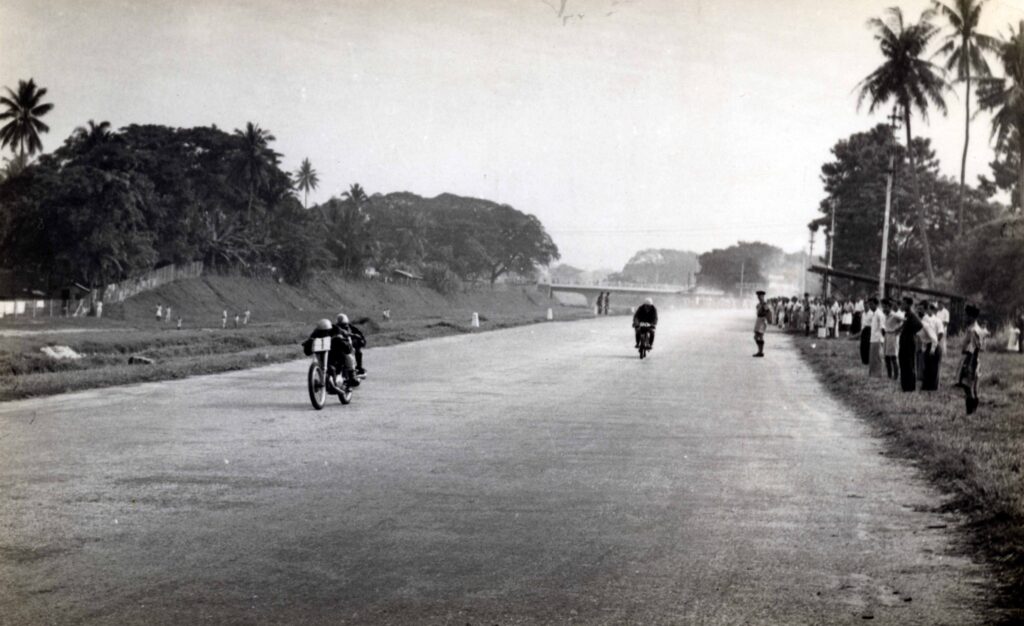
In the 1950s, Malayan enthusiasts were limited to the Lornie Kilo and Klang Hill Climb events in Kuala Lumpur, aside from the Johore Grand Prix and sprint and hill climbs up in Penang and Ipoh and speed events down in Singapore. Things took a turn for the worse for Selangor’s enthusiasts in 1958.
RETHINK: The Lornie Kilo had generated a very strong following over the years and in May 1958, the MMSC proposed an extension of the course to 1,320 yards (1.2km). A name change was necessary – the Lornie Speed Trial was suggested. An event was proposed for 1st June 1958, but all hope was scuppered when approvals from the Kuala Lumpur Municipal Council were not forthcoming. It was a similar case for the Klang Hill Climb when building of the new Istana on top of the hill put an end to this as well. Such was the pace of development taking place in the Federal Capital’s 37 square miles (population 315,000 in 1957 versus est 94 sq miles today with a population in excess of 1.8m) that it was increasingly difficult to secure a site for a Sunday of club racing.
The MMSC persisted and in December that year, the Bungsar Speed Trial, held alongside the Klang River just south of Kuala Lumpur, attracted entrants from all around Malaysia and Singapore. Unfortunately, this too was a short-lived endeavour.
AROUND THE HOUSES: More lobbying was necessary by the MMSC before another site was secured. The club had identified a venue that could handle both a sprint and a hill climb. In March 1960, the newly developed Diplomatic Enclave of Kenny Hill and the Lake Gardens south of Kenny Road came alive with the vibrant, discordant sounds of production and racing cars from the furthest reaches of the Peninsula.
The fastest time of the day award went to Singaporean racer and race car builder Lim Peng Han in his Lim Special. Tan Ah Kiong set FTD in the motorcycle event in his 500cc Norton. Annie Choong, former Malayan champion sprinter turned short term racing motorcyclist, beat five male riders to take the top award in the up-to-100cc class in her BSA Dandy. Local favourite Saw Kim Thiat won the Series Production Sports Car class in his Triumph TR3 as well as the Unlimited Cars class in a Mercedes 300SL Gullwing, the only Gullwing ever to have raced in Malaysia.
This Sprint was the turnaround for bigger and better things for the MMSC and Selangor racing fans. It was time to expand the program. The club’s President, Dr. Bill Dyson, and his committee were a committed bunch and faced stiff competition from regional and local events such as the Sembawang RASC Circuit Races in Singapore, the Singapore Grand Prix on Upper Thomson Road, and the Johore Grand Prix, all circuit races.
STEPPING UP: The MMSC took the bold step of hosting an even bigger event in October 1961, incorporating a 2,000-yard (1.83km) Hill Climb at the Diplomatic Enclave. They called it the New TAR Speed Trial and Hill Climb, to honour Malaysia’s first Prime Minister from independence in 1957, Tunku Abdul Rahman Putra. As expected, it attracted many competitors hungry for action. It was quite an astonishing turnaround as nearly every government department was involved in the preparation and running of the New TAR Speed Trial and Hill Climb. The resounding success of the Singapore and Johore street races may have had something to do with this. Corporations took an interest and sponsorship was forthcoming from Wearne Brothers, Sime Darby (who provided Pyrene Fire Extinguishers), A.S. Watson, Cold Storage Malaysia and Shell Malaya.
The event brought out the very best of local competitors such as Saw Kim Thiat with his ex-Heath Lotus Eleven Le Mans Climax [View: The Tall Lotuser] and NSU Prinz. It also attracted enthusiasts and their race cars such as Peter Cowling’s very fast T51 Formula 2 Cooper Climax, Ian Barnwell’s Aston Martin DB3S [View: For the Price of A House], Barry Swann’s AC Ace, S. MacDonald’s Porsche 356 Super 90 and Dickie Arblaster’s giant-killing Austin Mini.

Cowling, who had set the lap record at the Johore Grand Prix in June, also set FTD in his F2 Cooper at the New TAR Speed Trial and Hill Climb. It was, however, Borneo Motors’ Dickie Arblaster who stole the show with some expert rear-wheel-off-the-ground cornering in his lightened 850cc Austin Mini. The little car had bagged class awards up and down the Peninsula after Arblaster had replaced the doors and bonnet with aluminium panels and the rear and side windows with plastic sheets. He also installed a Speedwell cylinder head with larger ports and valves fed by twin Amal carburettors, a Jaguar-type high pressure fuel pump and a Downton exhaust manifold. The Mini wasn’t far off the time set by Saw in the Lotus Eleven.
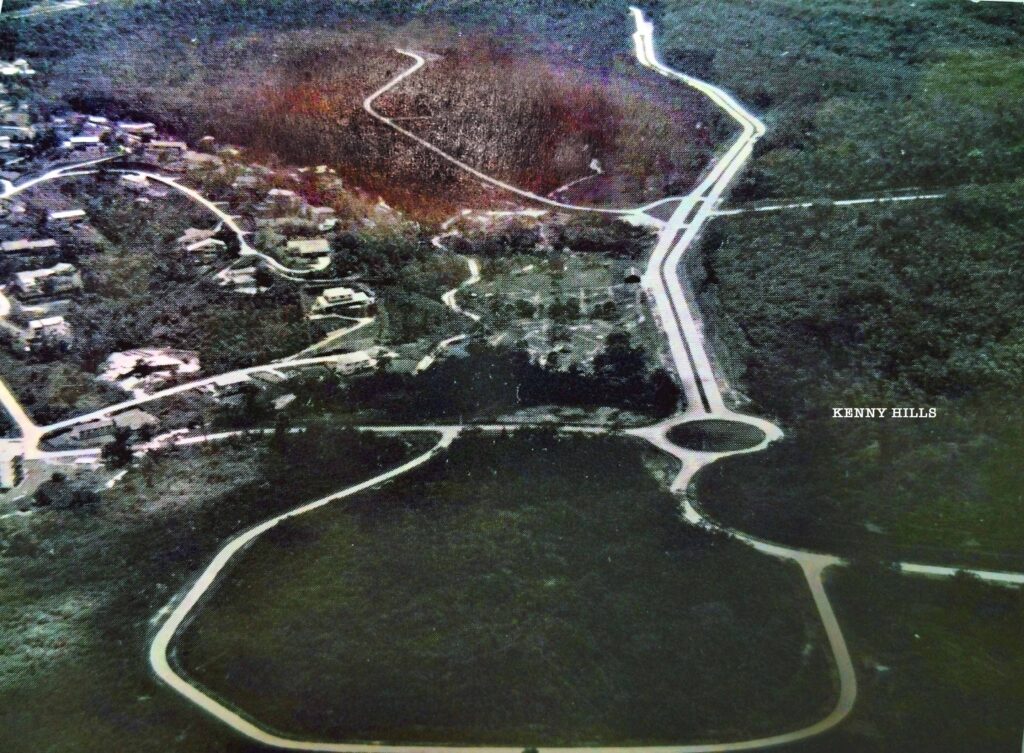
FIRST GRAND PRIX: Malayan enthusiasts had it good in 1962. They could participate in no less than ten events in the region, starting from the Gap Hill Climb in Singapore in February and finishing off with the MMSC’s Kuala Lumpur Circuit Race in November.
The motorcyclists beat the racing drivers to circuit racing in the Federal Capital by four months when the MMSC ran its first Motorcycle Grand Prix in mid-July, using the newly-constructed dual carriageway off Kenny Hill as part of 1.2-mile (1.93km) course. The 15-lap (18miles/29km) race was won by Singapore’s Albert Lim, riding his Norton Manx. Singapore riders filled the top five positions.
A week after the Macau Grand Prix in November, the MMSC closed the season with the Federal Capital’s first motor car Grand Prix. Held on 25th November, the 1.8-mile Diplomatic Enclave Circuit Race was only for cars. The event, renamed the Tunku Abdul Rahman Grand Prix (in place of the Tunku Abdul Rahman Sprint) was touted as “the chief motoring annual event in Kuala Lumpur.” The MMSC were modest in their expectations – Competition Secretary Lt. Col. Trevor Butcher initially planned for a 25- to 30-lap race around the circuit. It turned out to be a 35-lap Grand Prix.
The course included a horse-shoe bend, a hill, a chicane, straights and bends, and just 12 cars allowed on the circuit for each of the races. Each corner was named after one of the motoring personalities in Malaya. Cowling’s Curve (after Johor-based planter Peter Cowling), Fitton’s Folly (after MMSC Secretary Keith Fitton), Dyson’s Dice (after MMSC President Bill Dyson), John’s Horror (after engineer Freddie A. Johns), Butch’s Bend (after MMSC Competition Secretary Trevor Butcher), Spragge’s Chicane (after MMSC Club Captain Mike G. Spragge), Mole’s Hill (after MMSC PR officer Peter Mole), Lye Choon’s Delight (a 300-yard straight named after Singapore motor car omporter Chan Lye Choon) and Saw’s Sorrow (after local ace Saw Kim Thiat). Said the Prime Minister, patron of the MMSC, “Kuala Lumpur is not able to stage a Grand Prix yet like Johore Bahru and Singapore, but this competition should provide excellent experience for local drivers and a lot of excitement for the local public.” Prophetic words, indeed.
The Prime Minister flagged off the main race for Formula Libre cars, with eight starters blasting off for 35 laps (112.7km) of Selangor’s first mass-start motor race. In total, Butcher and his crew had managed to attract 46 entries for the six-event race weekend around the fenced Enclave Circuit. Formula Libre entries included Bill Cowie in a Jaguar E-Type Roadster, Bill Wyllie [View: On The Stroke Of Two] in an ex-works Lotus 17, John Armstrong in a Lotus 7, Chan Lye Choon in a Lotus 20B, Alex Johns Putra in a Triumph TR2, Saw Kim Thiat in a Lotus Eleven Climax [View: The Tall Lotuser], Robert Lee in his Robert Lee Special, Freddie Johns in a Jaguar E-Type Roadster, S. Nadarajah in a 1500cc MGA, Eric Cooper in an Austin Healey Sprite, R. Sivaganam in an Austin Healey 3000 and John Wright in a Jaguar E-Type Coupe.
Singapore’s top racer and 1958 Macau Grand Prix and 1961 Johore Grand Prix winner Chan Lye Choon won the race in his Lotus. Bill Wyllie finished second and John Armstrong was third. Chan also set FTD in the race, leading from start to finish. In the five support races, BMW 700s fought it out with Austin Healey Sprites, Austin Mini Coopers, Alfa Romeo Giuliettas, MGAs, Big Healeys, Triumph TR2s and Jaguar E-Types. Chan also had his little Lola Mk1 Climax entered in the Sports Cars 7-lap race.
Undoubtedly, the occasion was big enough to attract the region’s up-and-coming race drivers to participate, such as Rodney Seow with his Okrasa-tuned VW Beetle from Singapore. With the Malaysia Grand Prix (held in Singapore 1962-1965) over Easter, and the Johore Grand Prix in August, the Kuala Lumpur event gave enthusiasts a chance to race in an unheralded trio of Grands Prix in the region.
BIG ENTRIES: For the 11-event race meeting in November 1963, there were a total of 128 entrants. This time, motorcycles were included. The list of bike entries was impressive, but a look at the Formula Libre entry lists showed some interesting machinery – an Aston Martin DB3S, Lotus 15, Jaguar E-Type Coupe, MGA Twin Cam, Daimler SP250, Turner Climax, Olge SK1000, Lola Mk1 Climax and Triumph TR3.
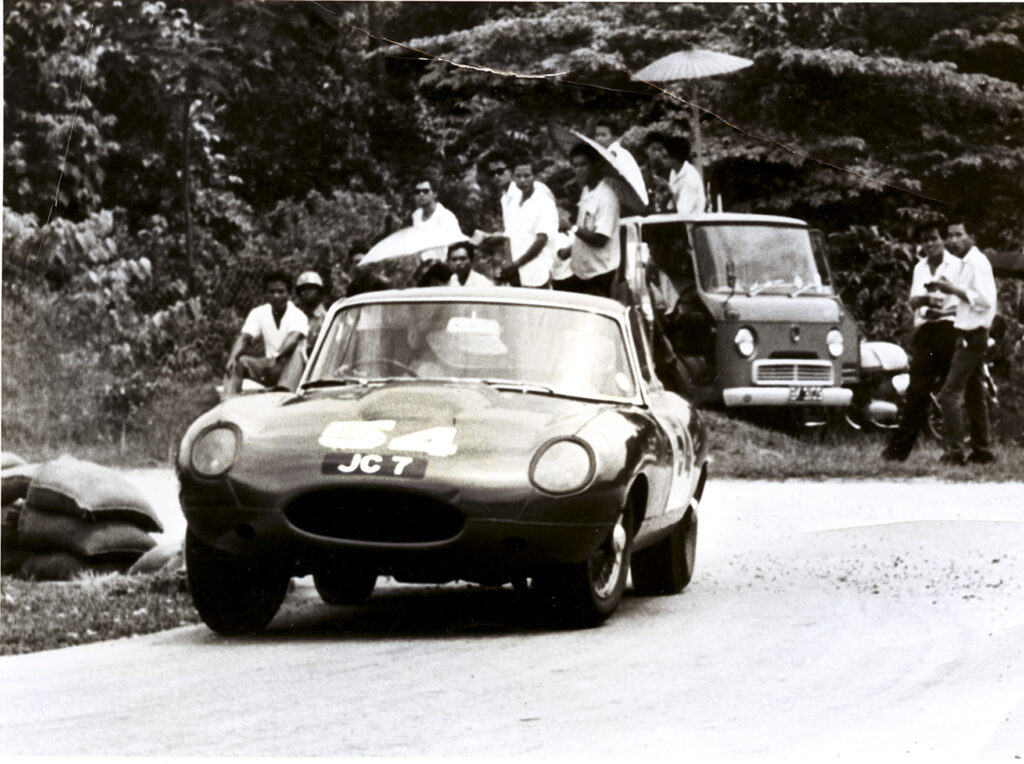
Malaysia’s Public Works Department engineer John Wright won the 35-lap Formula Libre Grand Prix in his Jaguar E-Type Coupe. He beat eight other entrants in pouring tropical rain, with Lord Angus Clydesdale coming in second in his RAF-rebuilt Lola Mk1 Climax and Mike Hunt third in a Mini Cooper S. Previous year’s winner Chan Lye Choon, who trailed Wright for most of the race, dropped back to finish fourth in his Lola Mk1 Climax when the weather turned foul.
Dick Clinkard won the Saloons & Tourers race in his factory-prepared blue 3.8-litre Mk2 Jaguar, nicknamed “Endeavour”. Clinkard also won the Saloons & Tourers event up to 1000cc in his little Simca. Chan Lye Choon, in arguably his last race before retiring from racing, won the under 1300cc Sports & GT Cars race in his Lola.
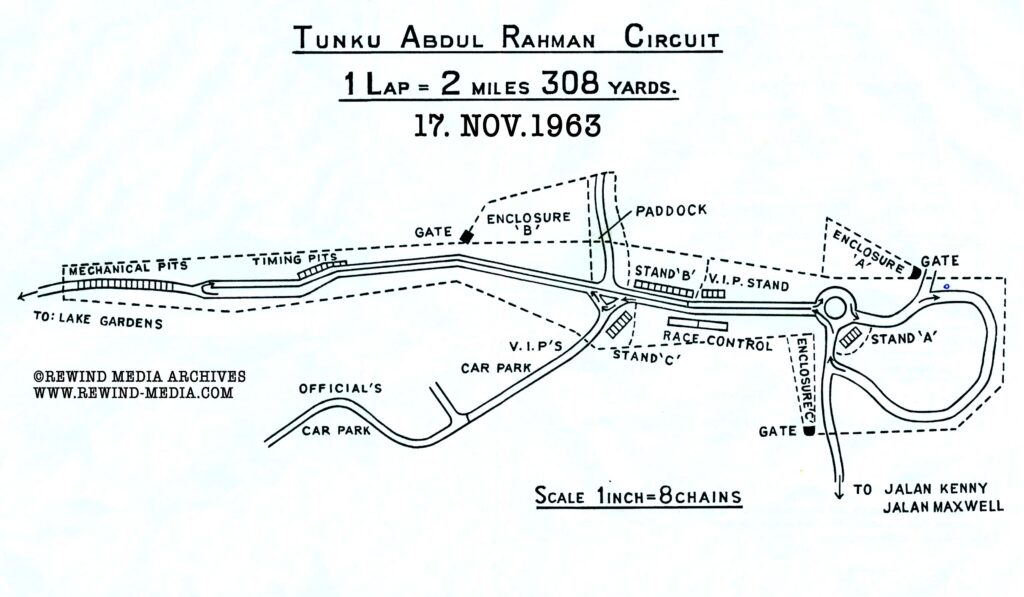
PERMANENT CIRCUIT: The Diplomatic Enclave Grands Prix only ran between 1961 and 1963, the latter two years as a mass-start circuit race. In 1964, the Federation International Automobile (FIA) sanctioned motorcycle racing for the MMSC’s third TAR Circuit Race which was set for 4-5 July 1964, but at a new 2.7-mile venue in Petaling Jaya, which had celebrated its 10th birthday in early 1963 as Malaysia’s first ‘new town’. The Start-Finish line was at S19-1, close to the Rothmans HQ. The course ran along Jalan University, into Jalan Kemajuan and Jalan Bersatu, and back again to the Rothmans building. Races for cars were included – a move that proved very popular amongst racing enthusiasts. There was an issue however. Factories in the vicinity had their approach roads blocked during race weekend
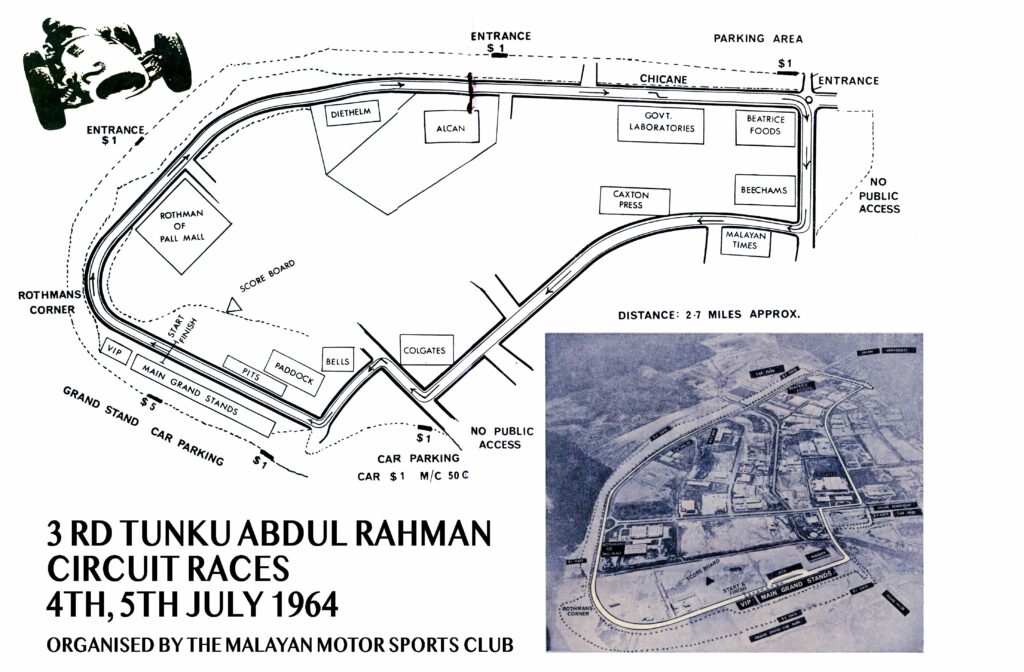
The 1964 circuit in Petaling Jaya enveloped several large production facilities. Examples included Rothmans, Caxton Press, Beechams, Diethlem, Alcan, Colgates, Beatrice Foods and Malayan Press. Entrance to the circuit was via Jalan University (now known as Jalan Prof Diraja Ungku Aziz).
The course was adjusted slightly for the 4th TAR Circuit Race in 1965, and the following year, the 5th TAR races were held at a site near Sungei Renggam [https://en.wikipedia.org/wiki/Shah_Alam], yet another temporary location, but one which the organisers hoped would accommodate 50,000 spectators. Interestingly, this very site would evolve, after considerable construction work was carried out, into the Batu Tiga racing circuit in 1967 following lobbying by the MMSC, with tacit support from Rothmans and its Managing Director John M. Brown. Brown had been in Malaya since 1949 so knew the landscape well. He had been promoted to MD of Rothmans of Pall Mall (Malaysia) Ltd. in 1964 and remained with Rothmans in Malaysia until he moved to London in early 1968. With Brown’s support (and local Rothmans man Lee Mau Seng), MMSC’s Desmond Gustavus (who had been on the MMSC’s committed since 1960!) was able to build a compelling case in front of Malaysia’s Minister of Transport Tan Sri (later Tun) Sardon bin Jubir (Minister for Transport 22 August 1959 – 3 June 1969) in late 1965. Further meetings were held with the Selangor State Government in early 1966 and with Mentri Besar (Chief Minister) Dato’ Seri Harun bin Haji Idris. A 10-year tenure was agreed upon on the basis that the MMSC would find sponsors to provide the building infrastructure while the State Government provided the land and road network. A site survey took place in February 1967 and by mid-June that year, metalling of the track began. When the first races took place in August 1967, it was all rather basic – no stands at Rothmans Corner or at Milo Hill, no air-conditioning VIP boxes and little to no TV towers around the circuit. All that would change before the first Selangor Grand Prix was held in 1968. Batu Tiga’s circuit also firmly established Malaysia on the racing map. But that’s another story.
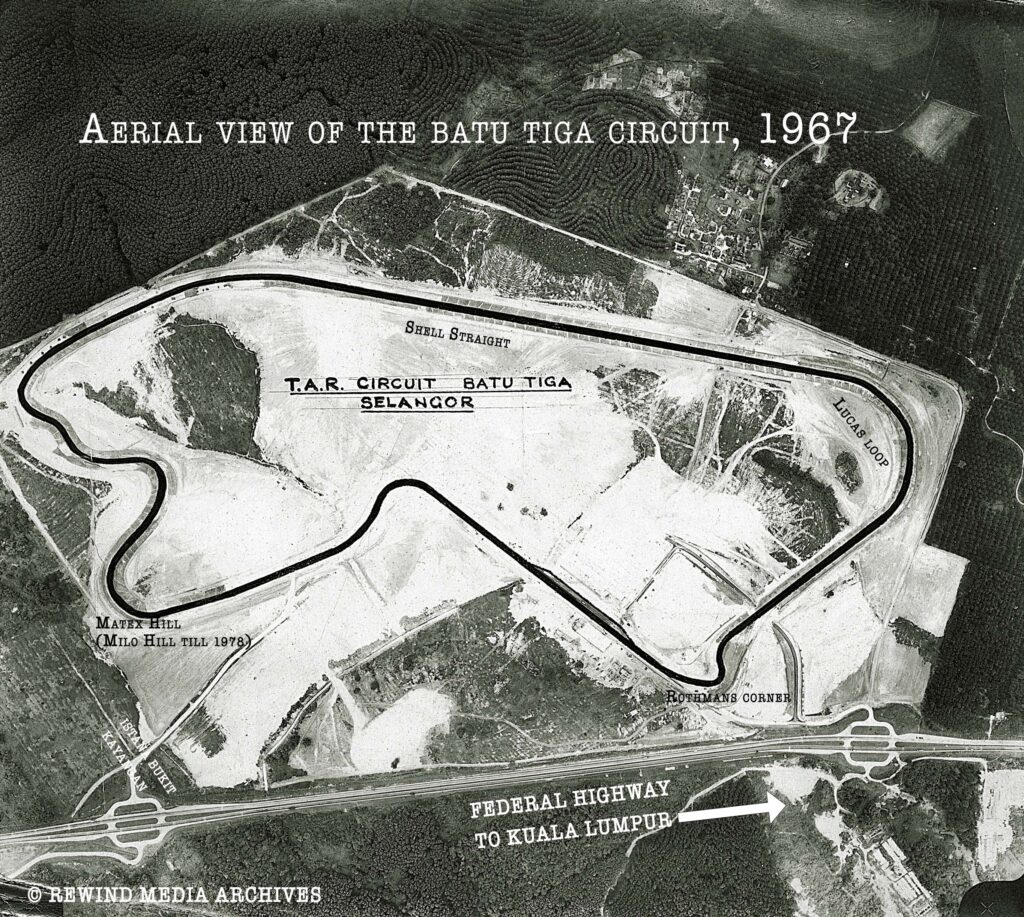
Did you race at Batu Tiga/Shah Alam or around the Dip. Enclave? Do you own a car that raced in this part of the world? If so, drop us as comment below. Love to hear from you.
Words by Eli Solomon
Captions

